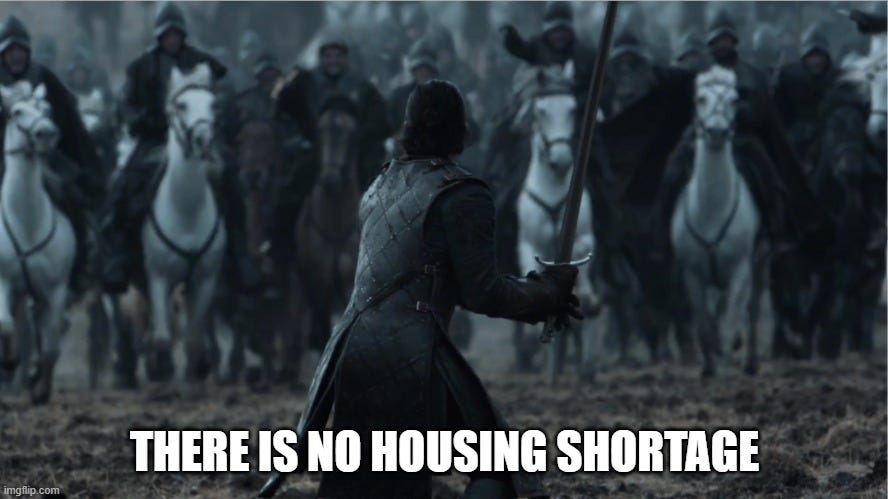There is no housing shortage (reprised, revisited, and reaffirmed)
It's a buyer's market out there, especially if means regress in the ways that they do
Some housing related things, in the ongoing saga of our totally not shortaged housing market
‘if you exclude the surplus, there’s definitely a shortage’ aka there’s a surplus now, if you know how to count
ask the Dallas Fed: ‘when price:rent ratios get outta whack, what happens next? do rents increase suddenly, or do prices stagnate and fall?’ you’ll never guess the answer
it’s a buyers market out there, or tales from the rapidly rising inventory front, and a ibuyer gone very cold
👉👉👉Reminder to sign up for the Weekly Recap only, if daily emails is too much. Find me on twitter, for more fun. First, sign up for your free trial of AlphaSense, because why wouldn’t you?
A plug for our sponsor, AlphaSense
AlphaSense is actually an amazing one-stop-shop for:
expert calls (especially since it acquired Tegus),
company-filings, and
analyst research;
plus, it’s got a pretty neat generative AI-search tool that I’ve been playing with a lot (which makes searching across the corpus of information much easier than before).
It’s a genuinely fun and very useful platform, and as part of the sponsorship, Random Walk readers have ACCESS TO A FREE TRIAL, which you’d be a fool not to try (just by clicking through the link below):
FREE TRIAL! FREE TRIAL! FREE TRIAL!Give it a shot. It’s a great platform.
There is no housing shortage (reprised, revisited, reaffirmed)
Just some quick hitters on the wrongest thing the most people believe to be true.
Come at me, shortage bros.
‘If you exclude the surplus, there’s definitely a shortage’
When scientists confidently declare the sheer magnitude of the supposed housing shortage, they typically refer back to some golden age of unfettered building. Downward deviation from this past, is the NIMBY-sin.
It turns out, though, that the baseline “vacancy rate” (from which the “correct” amount of vacancy is extrapolated) is derived (in part) from the peak vacancy rates that preceded the global financial crisis.
In other words, the “correct” amount of houses we should be building (based on how many homes we’ve made in the past), assumes at no point did we ever perhaps make more houses than we needed.
So argues a paper from April 2024 titled “Where is the Housing Shortage?”
As you can see, vacancy rates do not appear to be unusually low:
Total vacancy rates trended well-above the long-term average right up until 2020-21.
Of course, we know what happened in 2021: houses didn’t suddenly disappear, and nor did millions of new Americans suddenly arrive. There was, instead, a fairly seismic shock to patterns of life of living . . . that was followed by historic levels of new builds (after the series ends).1
So, there was no shortage before the pandemic, and surely no shortage afterwards.
But, if you index to a period of exuberant building, then you might conclude that we’re never quite exuberant enough:
The [housing] stock increased by 8.8 million units from 2010 to 2020. During this period, stock expansion was slower than household growth (10.1 million), but the inventory of vacant units from the bubble provided more than enough units to satisfy the growth in households not accommodated by increased housing production.
Perhaps this recent decade of housing stock expansion failing to keep pace with house-hold formation has led analysts to believe that the housing industry has failed to produce enough units.
Over the entire period, 2000 to 2020, it is clear that the stock expanded by more than enough to meet the needs of household growth, suggesting that there is no overall shortage of housing. From 2000 to 2020, the number of households grew by 21.3 million (an average of about 1.07 million net new households per year). During the same time period, the housing stock expanded by 24.6 million units (about 1.23 million units per year). The excess stock expansion suggests that there was a surplus, not a shortage, of about 3.3 million units in 2020
New builds wildly outpaced household growth from 2000-2010 (interrupted by the housing bubble bursting), leading a surplus of homes large enough to cover the “underbuilding” from 2010-2020.
In table form, over the entire 20 year period, housing growth outpaced household growth:
Keep reading with a 7-day free trial
Subscribe to Random Walk to keep reading this post and get 7 days of free access to the full post archives.





